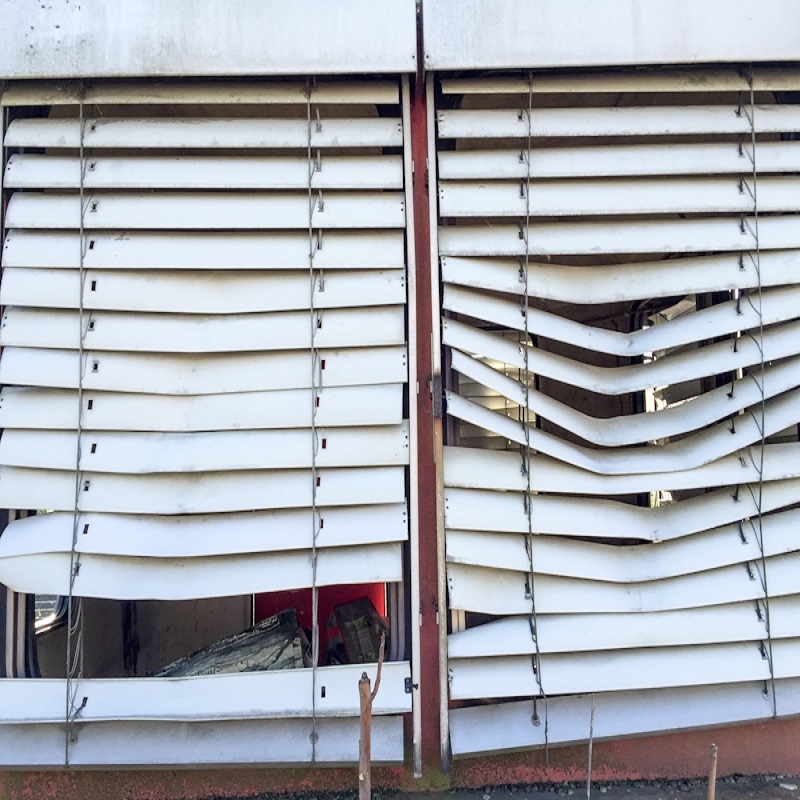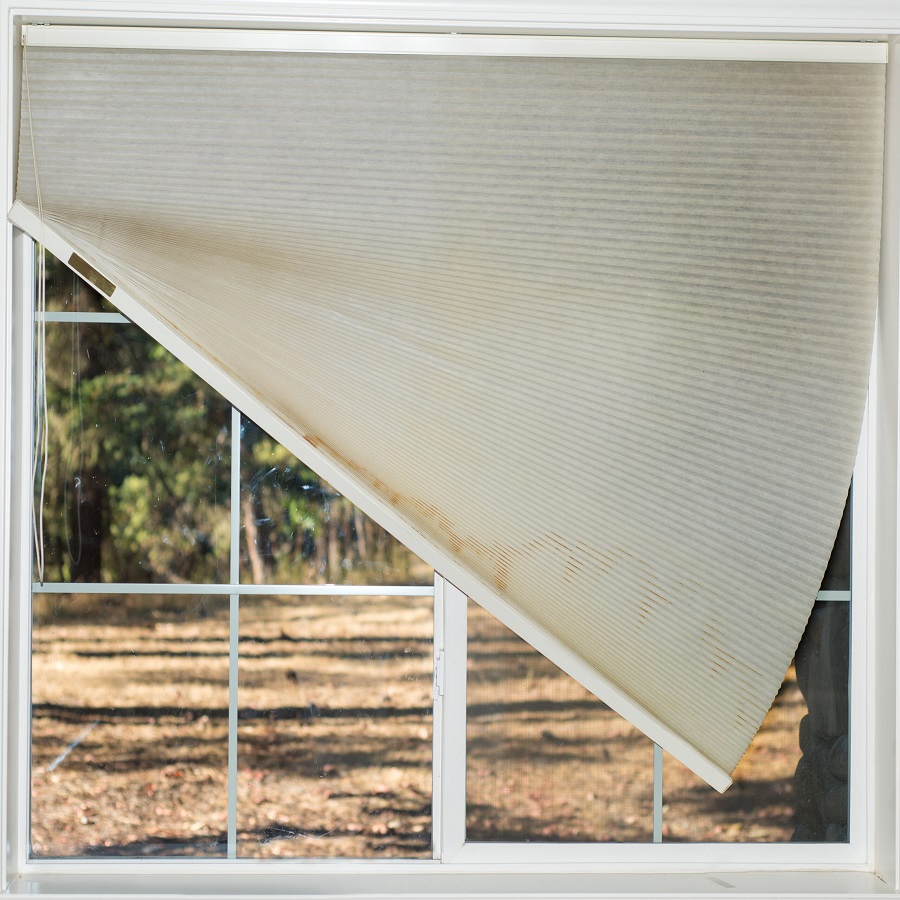Identifying Common Blind Problems
Window blinds enhance home aesthetics but can face issues. Here, common blind problems are listed with their signs and simple fixes.
Tangled Cords
Cords can tangle, making blinds tough to use. Gently untangle them, using a needle for stubborn knots.
Broken Slats
A broken slat disrupts blind function. Replace it by measuring and cutting a new one to fit.
Loose Brackets
Brackets may loosen over time. Tighten or replace screws to secure the blinds back in place.
Dust Accumulation
Dust reduces blinds’ appeal and can cause wear. Clean with a soft cloth or a duster regularly.
Discolouration
Fading colours can occur from sunlight or moisture. Clean blind and use colour restorers if needed.
Stuck or Difficult-to-Operate Mechanisms
If blinds get stuck, check for blockages. Lubricate the mechanism with silicone spray for smoother operation.

Step-by-Step Repairing Process
Fixing window blinds might seem daunting, but it’s straightforward with the right guidance. Here’s how to handle the most common repairs.
Removing and Replacing Broken Slats
Broken slats are often easy to replace. First, gently remove the damaged slat. Measure and cut a new one that matches the size. Slide the new slat into place, ensuring it fits snugly.
Untangling and Repairing Cords
Tangled cords can be a nuisance. Lay the blinds flat and slowly work out the knots. Use a blunt needle to ease out tight tangles. Once untangled, hang the blinds back up and test the cords.
Securing Loose Brackets
Loose brackets can make blinds unstable. Remove the blinds and tighten all screws on the brackets. If screws are worn, replace them with new ones of the same size. Reinstall the blind and check they’re held firm.
Cleaning and Maintaining Blinds
Regular cleaning prolongs blind life. Dust each slat from top to bottom with a microfiber cloth. For tough grime, use a damp cloth with a mild cleaner. Dry thoroughly before rehanging to prevent mold growth.
No-Drill Solutions for Blind Installation
Installing blinds without making holes in walls is a simple task. This protects the wall and saves time. Here’s how to fix blinds using no-drill methods.
Using Adhesive Tapes for Mounting
Adhesive tapes can be a quick, no-drill solution for mounting blinds. Start by cleaning the surface where the tape will stick. Cut the tape to the length needed and apply it to the blind’s top rail. Press the blind firmly against the wall or window frame. This method supports light to medium weight blinds well.
Tips for Drill-Free Blind Repairs
For blinds that have fallen, use special double-sided adhesive tapes. Ensure the surface and blind are clean before applying the tape. Stick the tape to the blind’s top rail and set it in the desired position. Apply pressure for strong adhesion. Check the weight limit of the tape to support the blind. Wait for 24 hours before using the blinds, to let the tape bond fully.
By avoiding drills, you protect walls from damage and make for an easier setup. Regular checks and maintenance on the adhesive are needed to ensure blinds remain secure.

Advanced Repairs and Adjustments
In some cases, blinds may require more than basic fixes. Advanced repairs can address issues like crooked frames or damaged parts.
Fixing Crooked Frames
Crooked frames can make blind look uneven and work poorly. To fix them:
- Take the blinds down and lay them flat.
- Check the top rail for bends or warping.
- Gently straighten out any bent areas.
- Rehang the blind and check for alignment.
- If the frame is still crooked, you may need new brackets.
Replacing Damaged Parts
Sometimes, parts of the blind can wear out or break. Here’s what to do:
- Identify the broken part, like a cord lock or tilt mechanism.
- Order a replacement from the manufacturer or a blinds store.
- Follow the product instructions to install the new part.
- Test the blind to ensure they work correctly with the new part.
These repairs help keep blind functional and looking great. Remember to handle blinds carefully to avoid further damage.
Preventative Measures and Regular Upkeep
Regular care can make blinds last longer and work better. Learn some easy steps to keep blinds in top shape.
Dusting and Cleaning Techniques
Regular cleaning prevents dust build-up and keeps blinds looking sharp. Follow these steps:
- Use a microfiber cloth or duster to wipe each slat from top to bottom.
- For deep cleaning, use a mild cleaner with a damp cloth.
- Make sure you dry the slats fully before hanging them back up.
Clean blind won’t collect as much dust and will operate more smoothly. Aim to clean them at least once a month.
Lubricating Moving Parts
Lubrication helps blinds work better and stops them from getting stuck. Here’s how to lubricate them:
- Find the moving parts like cords and mechanisms.
- Apply a silicone-based lubricant to these areas.
- Move the parts back and forth to spread the lubricant.
Use the lubricant sparingly to avoid drips or stains. Check the blinds’ function after to make sure they move with ease.
By doing these regular upkeep tasks, blind will work well and look great. They will also be less likely to have problems in the future. If you keep up with these tasks, you can avoid many common blind issues.

When To Seek Professional Help
Sometimes, despite our best efforts, certain blind repairs are beyond DIY capabilities. It’s essential to know when to seek professional help to avoid causing further damage to your blinds.
Recognizing Unsolvable Issues
Identifying problems that require a professional can save you time and frustration. Look for signs such as:
- Mechanisms that refuse to function after lubrication and adjustment.
- Slats that have warped or bent beyond simple repairing tricks.
- Continuous operational issues even after replacing parts.
- When blinds are still stuck after attempting to fix them.
If you encounter these issues, it’s time to call in the experts.
Contacting Manufacturers for Assistance
Reaching out to the manufacturer can offer solutions not found in home repair attempts. Many companies provide:
- Warranty services for faulty or damaged parts.
- Guides or customer support for troubleshooting.
- Replacement parts or repair services specific to their products.
Check the blinds’ manual for contact details and warranties. A professional touch can sometimes be the quickest route to fully functional blind.
Signs That Professional Help is Necessary
In addition to the issues already mentioned, here are a few more specific situations where enlisting a professional might be warranted:
- Complex Mechanisms: If your blinds feature intricate mechanisms (like motorized or smart blinds) that are malfunctioning, attempting to fix these on your own can lead to more problems. These systems often require specialized knowledge and tools.
- Extensive Damage: If you notice extensive damage to the structure of your blinds, such as shattered slats or broken cords, a professional can assess the extent of the damage and determine whether repair or replacement is the best option.
- Increased Safety Risks: If your blinds are malfunctioning in a way that could pose a safety risk—such as if they’re stuck in a position that blocks a window or a door—it’s important to get help from an expert.
-
Aesthetic Concerns: Sometimes, the appearance of your blinds may be compromised, which can detract from the overall decor of your space. Professionals can often provide solutions that maintain the aesthetic appeal of your home.








